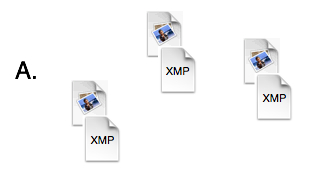3 minute read.Hybrid
So, back on the old XMP tack. The simple vision from the XMP spec is that XMP packets are embedded in media files and transported along with them - and as such are relatively self-contained units, see Fig 1.

Fig. 1 - Media files with fully encapsulated descriptions.
But this is too simple. Some preliminary considerations lead us to to see why we might want to reference additional (i.e. external) sources of metadata from the original packet:
- PDFs
- PDFs are tightly structured and as such it can be difficult to write a new packet, or to update an existing packet. One solution proposed earlier is to embed a minimal packet which could then reference a more complete description in a standalone packet. (And in turn this standalone packet could reference additional sources of metadata.)
- Images
- While considerably simpler to write into web-delivery image formats (e.g. JPEG, GIF, PNG), it is the case that metadata pertinent to the image only is likely to be embedded. Also, of interest is the work from which the image is derived which is most likely to be presented externally to the image as a standalone document. (And in turn this standalone packet could reference additional sources of metadata.)
(Continues)
Thus the two cases - PDF documents and images - are not dissimilar. Fig. 2 shows a “wall-to-wall” XMP architecture whereby the standalone metadata documents for the work and for additional sources are expressed in XMP.

Fig. 2 - XMP “wall-to-wall” architecture.
Fig. 3 presents a variant on this theme whereby additional sources are presented as generic RDF/XML. (In the most general case only RDF need be assumed, the serialization being a matter of choice.)

Fig. 3 - XMP authority metadata with references to generic RDF/XML
And finally, Fig. 4 shows the most extreme case whereby XMP is used merely to “bootstrap” RDF descriptions for media objects. The XMP is used to embed a minimal description into the media file with references to a fuller work description and to additional sources which are presented as generic RDF/XML. That is, the metadata descriptions use generic RDF/XML exclusively and only resort to the idiomatic RDF/XML employed by XMP for embedding descriptions into binary structures.

Fig. 4 - XMP “bootstrap” only - metadata descriptions proper are generic RDF/XML.
If I were to choose I might opt for the scenario presented in Fig. 3, but the scenarios in both Figs. 2 and 4 leave room for thought. Such a hybrid solution may be a means to bridge two different concerns:
- Generic RDF/XML for unconstrained descriptions.
- Idiomatic RDF/XML (aka XMP) for embedding the head of a metadata trail.
I’m not sure that I see the XMP spec loosening up any time soon to accommodate generic RDF/XML. Nor, likewise is XMP likely to be provided (or even tolerated) down the metadata trail. And the metadata is not going to be fully encapsulated within a media file. The media file will merely encapsulate the head of the metadata trail.










